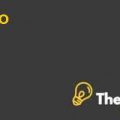Final Assessment Assignment Case Study Solution
Global Markets and Systematic Risk
What will be the consequences if during the life of project the global financial crises will occur like the global crisis from 2007 to 2009 have occurred? The company’s top executives are thinking about the consequences for its subsidiary which will stop working after completing its two or three years due to these types of global financial crises. As the global financial crises have occurred due to the fall in housing pricing in the United States of America, which is the result of questionable credit rating of home owners that have been taken the mortgages on their houses and were unable to repay it on timely basis (Reuters, 2018).
In case of the occurrence of such types of situations during the life of project that might lead to a decrease in demand of sunscreens in Brazil and the possible changes (appreciation and depreciation) in exchange rates between Brazilian currency and USD. These types of consequences during the project life time would lead to the low or even negative NPV as compared to expected NPV, which are in positive and provide reasonable good returns to its parent company after paying its debt repayments and interest expenses.(Havemann, 2010).
In order to maintain a consistency in the exchange rates between the Brazilian currency and USD, the company should make forward and future contracts in order to hedge money market crises in case of occurrence of same situation which arose from 2007 to 2009.
ECB’s monetary policy and provision of liquidity play main roles in enclosing the rationalized risk to maintain stability in price, economic activity and stable financial system in the market. By ECB, provisions of funding that might be unlimited and contain numerous nonstandard measures that can fix the interest rates and the inflation rates over the period of six months, which will help to supply products in other countries. This export will help to maintain its forecasted demand,which will not be affected by the global financial crises, ultimately resulting in stagnant revenues and profits.(European Central Bank, 2009).
The company can make swap agreement with Federal Reserve authorities which provides stability in interest rates and inflations rates up to certain period. In conclusion, these types of future hedging contracts such as swaps and forward and future contracts can help the company to mitigate the negative consequences that might occur due to the occurrence of global financial crises during the life of the project.
Recommendation:
After making the detailed analysis of cumulative NPV and return on investment, it has been recommended to the company to have an investment in Brazilian subsidiary which will provide stable and good return on initial investment that will be made by the parent company to its subsidiary. In order to make accurate and justifiable forecast, two methods have been used to find NPV at 0 period for five years life of a project with constant demand and an increase in the variable and fixed costs according to the inflation rate which is expected 6% for next five years.
In first method of calculating NPV 70% debt has been taken in Brazil where the interest rate on debt is 7% along with the annual repayments of debt up to the project lifetime. The project NPV after taking the loan form Brazilian bank will provide the project return of 130% on investment. This high return is due to the 20 % markup on facilities that contains 60 % project value and is wholly allowable for depreciation according to the Brazilian tax laws. Apart from this Brazilian tax law, there isn’t any capital gain tax that will help to increase NPV for the five years project life.
In the second method of calculating NPV where 70% debt has been taken in the United States where the interest rate on debt is 3% along with the annual repayments of debt up to the project life. The project NPV after taking the loan form American bank will provide the project return of 147% on investment,which is greater than the return by taking the debt form Brazilian bank.
Apart from it, if Pretty Face wants to invest its five year life project wholly form equity financing than it should issue shares in the United States because its required rate of return is 8.63%, which is less than the required rate of return from Brazilian shareholders i.e. 14.05%. The difference between these two required rates of return is 5.43 %, which is much higher, leading to a decrease in NPV for the parent company “Pretty Face”for investing in five year life project in its subsidiary in Brazil.
Conclusion:
To sum up, the parent company Pretty Face should take loan from the United States and invest that loan in Brazil. Since, the rate of interest in the United States is 3% while the rate of interest in Brazil is 7%, by taking debt from the United States, the net present value would be increased by 17% as compared to taking debt from Brazil. The company would be benefited if it would take debt from the United States. If the company would intent to wholly finance the business from equity then it is recommended that it should issue shares in the United States because of the fact that the required rate of return in the United States is lower as compared to Brazil.....
This is just a sample partical work. Please place the order on the website to get your own originally done case solution.











